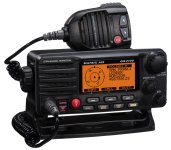Standard Horizon has come out (not yet in the stores) a new VHF radio, with a Class D DSC reciever, and AIS reciever, VHF radio, Hailer combo with available use of RAM mikes.
I believe that this is the first combination AIS reciever, VHF radio combination, and it is going to be a winner at about $400. Granted, that there is no class B transmitter, for most of our uses, the AIS reciever will do the job.
So maybe that AIS is not that far off. I wonder when this is incorporated into their chart plotter? (There is NMEA output for any brand plotter).
I believe that this is the first combination AIS reciever, VHF radio combination, and it is going to be a winner at about $400. Granted, that there is no class B transmitter, for most of our uses, the AIS reciever will do the job.
So maybe that AIS is not that far off. I wonder when this is incorporated into their chart plotter? (There is NMEA output for any brand plotter).

